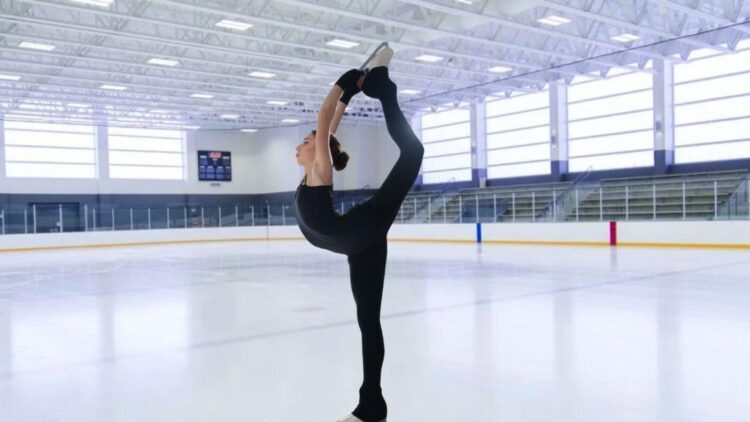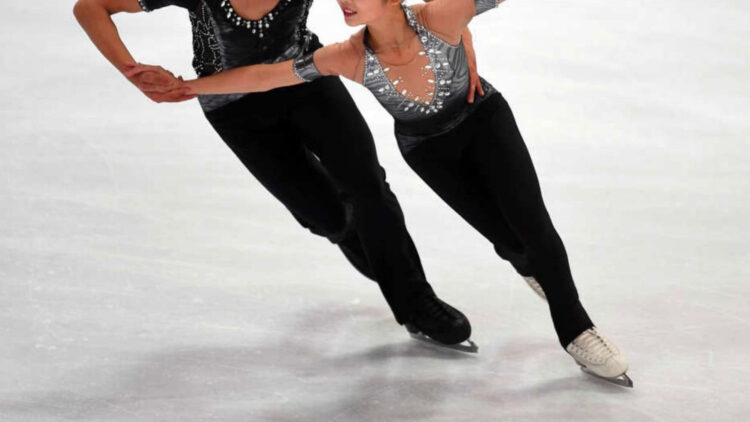
OBJECTIVE OF FIGURE SKATING: Score the most points possible by impressing judges in various technical and artistic categories.
NUMBER OF PLAYERS: 1+ or 2+ players depending on whether competing in singles or pairs
MATERIALS: Figure skates, decorative wear
TYPE OF GAME: Sport
AUDIENCE: 5+
OVERVIEW OF FIGURE SKATING

Figure skating is an artistic discipline of ice skating that involves one or two skaters performing for a panel of judges. While figure skating is considered a sport, it is more or less a dance performance done on ice, as competitors perform intricate routines synchronized to music.
Figure skating is thought to have originated, at least to some degree, with the invention of ice skates. Archaeological finds have unearthed bone-based ice skates dating back to 3000 BC, although the exact time period in which humans learned to skate on ice is not entirely known.
The first documented evidence of figure skating can be traced back to a 12th-century book written by an English monk. In this book, the author compares children gliding across the ice to birds or arrows flying through the air.
Modern figure skating became an officially recognized sport once the International Skating Union was formed in 1863.
Since then, figure skating has become a popular international sport, with many competitions and events held throughout the 19th and 20th centuries. Figure skating has been an Winter Olympics sport since the 1908 (Summer) Olympics and has evolved throughout the years. Now there are several Figure Skating competitions including the World Championships.
SETUP
EQUIPMENT
- Figure Skates: A stiff boot fixed atop a metal blade. Unlike many other skates, figure skates generally have a raised heel. The most distinctive feature of a figure skate is the toe pick on the front of the blade used to dig into the ice for traction when necessary.
- Decorative Wear: There are no required outfits or uniforms in figure skating; however, due to the artistic nature of the sport, many competitors dress in elegant clothing to match the theme of their performance.
EVENTS
At the Olympic Winter Games level, there are three main disciplines of figure skating events:
1) SINGLES
A program designed for a single male or female skater. In single skating, competitors are required to complete two different skates:
- Short Program: These programs last two minutes and 40 seconds in length and require the skater to complete a series of spins and jumps as part of their performance. Both men and women must complete seven compulsory moves, although some spins and jumps are adjusted between groups.
- Long Program/Free Skate: A long program lasts four minutes in length and gives the skater more freedom in how they want to structure their routine. In their programs, skaters are recommended to include seven jumps, three spins, one step sequence, and one choreographic sequence. In the free skate, judges expect skaters to utilize the entire rink and avoid spending too much time skating with both skates on the ice.
2) PAIRS

Pair skating is designed for a team of two figure skaters—one man and one woman. Similar to single skating, athletes compete in two skating events:
- Short Program: Skaters must execute seven compulsory moves throughout their two-minute and 40-second routine. These exact sequences change every season, although they always consist of spins, jumps, and lifts. Lifts are unique to pairs skating and feature the male skater lifting the woman into the air.
- Long Program/Free Skate: Like single skating, long programs last four minutes in pairs competitions. Throughout these performances, skaters are encouraged to perform traditional pairs moves, such as lifts and assisted jumps. Additionally, pairs should perform single skating moves in unison—that is, performing the same moves simultaneously in what is known as “mirror skating” or “shadow skating”.
3) ICE DANCE
Ice dancing is a form of figure skating that attempts to mimic ballroom dancing. Because of this ballroom dance parallel, ice dancing is always an event done in pairs. In this event, competitors must complete two separate routines:
- Rhythm Dance: These programs must last two minutes and 50 seconds in length and are choreographed to a predetermined rhythm and theme provided by the organizer of the competition. In addition to the choreographed elements, skaters must include in their programs a six-second lift, a set of twizzles (one-legged spins), and a step sequence.
- Free Dance: Free dance programs last four minutes in length and must utilize the entirety of the ice surface. In these programs, skaters must display their own well-known dance steps, as well as numerous required lifts, spins, and step sequences. In the free dance, judges are looking for creativity and expression, as well as excellent technique.
GAMEPLAY
SCORING
Figure skating utilizes a complex scoring system that judges skaters on the degree of difficulty of their program, how well they execute specific routine elements and their overall skating performance.
Each element performed in a skating program has a base value assigned to it; this value is how many points the element is worth, with this number being dependent on difficulty. Judges critique each element by providing a grade of execution score between -5 and 5. In simpler terms, a particular element may have a base value of 10 points, but the execution of that element by the skater(s) can result in a score as low as 5 points or as high as 15 points.
In addition to the grade of execution scores (known as the technical score), judges also critique a skater’s performance based on five distinct categories:
- Skating Skills: Overall quality of skating. This category focuses on the skater’s steps, turns, speed, edge control, and accelerating technique.
- Transitions: The movements and footwork that connect two elements together.
- Performance: The skater’s physical and emotional ability to execute the choreography of their routine.
- Composition: The overall flow of the program. This includes the use of space, patterns, and the phrasing of elements.
- Interpretation of Music: The creative ability to sync the performance with the musical track.
All five program components are scored between 0.25 and 10 points. This means a maximum of 50 points can be scored if a perfect 10 is awarded for each program component. A skater’s program component score is then added to their technical score.
A skater’s final score combines their skating routines, such as long and short programs for singles and pairs and rhythm and free dance for ice dancing.
DEATH SPIRALS
Slow Motion ‘Death Spiral’ by Olympic Pair Skaters Kirsten Moore-Towers & Michael Marinaro
Despite its ominous name, the death spiral, often included in every pairs program, is one of the slowest elements in a figure skating routine. This move consists of the male skater slowly spinning in a circle while holding his partner’s hand while she’s essentially bent over backward with one skate on the ice.
In general, the goal of the death spiral is for the female skater to get as close to the ice as possible during the spin before recovering without losing a step.
END OF GAME
The skater(s) with the highest combined score of both programs is considered the competition’s winner.
- 30 GAMES TO PLAY OVER TEXT - April 22, 2024
- 20+ FREE PRINTABLE BABY SHOWER GAMES - April 16, 2024
- 20+ College Party Games for the Best Night Ever! - April 2, 2024